Geological Conditions and Sedimentary Models of Oligocene and Eocene Effective Source Rocks in the Northern Yinggehai Basin
Abstract
1. Introduction
2. Geological Background
3. Samples and Methods
3.1. Samples
3.2. Geological Analogy
3.3. Structural Evolution Profile Drawing Methods
3.4. TOC Analysis
3.5. Analysis of Major and Trace Element Contents
4. Results and Discussion
4.1. Tectonic Conditions
4.2. Depositional Conditions
4.3. Paleoenvironmental Conditions
4.3.1. Paleoclimate
4.3.2. Paleoproductivity
4.3.3. Redox Conditions
4.4. Sedimentary Model of Source Rock
5. Conclusions
Author Contributions
Funding
Institutional Review Board Statement
Informed Consent Statement
Data Availability Statement
Acknowledgments
Conflicts of Interest
References
- Li, J.; Yang, Z.; Wu, S.; Pan, S. Key issues and development direction of petroleum geology research on source rock strata in China. Adv. Geo-Energy Res. 2021, 5, 121–126. [Google Scholar] [CrossRef]
- Huang, B.J. Geneticype Sand Migration Accumulation Dynamics of Natural Cases in the Ying Qiong Basin the South China Sea. Ph.D. Thesis, Guanazhou Institute of Ceochemistry of Chinese Academy of Sciences, Guangzhou, China, 2002. [Google Scholar]
- Dong, W.L.; Huang, B.J. Identification mark sand source discrimination of the coal-type gas in Yinggehai Basins of South China Sea. Nat. Gas Ind. 2000, 4, 36–40. [Google Scholar]
- Tong, C.X.; Ma, J.; Pei, J.X.; Xu, X.D.; Liu, P. Geochemical Characteristics and Origin Types of Mid-Deep Natural Gas in Dongfang Area, Yinggehai Basin, Yinggehai Basin. Xinjiang Pet. Geol. 2015, 36, 258–263. [Google Scholar]
- Li, X.T.; Yu, S.Y.; He, J.X.; Ju, Y.W.; Zhang, W. Paleogene hydrocarbon sources and their petroleum geological significance in Yinggehai Basin, Northwestern South China Sea. Mar. Geol. Front. 2016, 32, 16–25. [Google Scholar]
- Guo, X.X.; Xu, X.D.; Xong, X.F.; Hou, J.X.; Liu, H.Y. Gas accumulation characteristics and favorable exploration directions in mid-deep strata of the Yinggehai Basin. Nat. Gas Geosci. 2017, 28, 1864–1872. [Google Scholar]
- Wang, Y. Source Composition, Hydrocarbongeneration Potential of Source Rocks and Its Control on Hydrocarbon Accumulation in YinagionaBasin. Ph.D. Thesis, China University of Minina & Technology, Beijing, China, 2018. [Google Scholar]
- Huang, B.J.; Huang, H.T.; Li, L.; Wang, L.F. Characteristics of marine source rocks and effect of high temperature and overpressure to organic matter maturation in Yinggehai-Qiongdongnan Basins. Mar. Orig. Pet. Geol. 2010, 15, 11–18. [Google Scholar]
- Xu, X.D.; Yang, J.H.; Liu, H.; Guo, X.X.; Xiong, X.F. Formafion mechanism of oroanic maer in source rocks under marine environment in Yingehai Basin. Eat. Sci. 2019, 44, 264–2653. [Google Scholar]
- Dahlstom, C.D.A. Balanced cross sections. Can. J. Earth Sci. 1969, 6, 743–757. [Google Scholar] [CrossRef]
- Hu, T.; Wu, G.; Xu, Z.; Pang, X.; Liu, Y.; Yu, S. Potential resources of conventional, tight, and shale oil and gas from Paleogene Wenchang Formation source rocks in the Huizhou Depression. Adv. Geo-Energy Res. 2022, 6, 402–414. [Google Scholar] [CrossRef]
- Petersen, H.I.; Tru, V.Q.; Nielsen, L.H.; Duc, N.A.; Nytoft, H.P. Source rock properties of lacustrine mudstones and coals (Oligogene Dong Ho formation), onshore Sond Hong basin, norththern Vietnam. J. Pet. Geol. 2005, 28, 19–38. [Google Scholar] [CrossRef]
- Andersen, C.; Mathiesen, A.; Nielsen, L.; Tiem, P.V.; Petersen, H.; Dien, P. Distribution of source rocks and maturity modelling in the northern Cenozoic Song Hong basin (gulf of tonkin),Vietnam. J. Pet. Geol. 2005, 28, 167–184. [Google Scholar] [CrossRef]
- Petersen, H.I.; Fyhn, M.; Nytoftt, H.P.; Karen, D.; Lars, H.N. Miocene coals in the Hanoi Trough, onshore northern Vietnam: Depositional environment, vegetation, maturity, and source rock quality. Int. J. Coal Geol 2022, 253, 103953. [Google Scholar] [CrossRef]
- Li, Z.H.; Chen, H.C. Oragnic mechanism and source rocks for natural gas in Qiongdongnan basin, South China sea. Pet. Geol. Exp. 2011, 33, 639–644. [Google Scholar]
- Fan, C.W. Tectonic deformation features ard petroleum geolocical significance in Yinggehai large strike-slip basin, South China Sea. Pet. Explor. Dev. 2018, 45, 190–199. [Google Scholar] [CrossRef]
- He, J.X.; Shi, X.B.; Xia, B.; Liu, H.L.; Yan, B. The satus of the petroleum exploration in the northern South China sea and the resource potential in the deep-water areas. Adtances Earth Sci. 2007, 22, 261–270. [Google Scholar]
- Li, H.; Wang, P.; Xu, H.; Shen, L.; Chen, T.; Lei, G. Comparison of overpressure system and hydrocarbon accumulation between Qaidam basin and Yinggehai basin. J. Nat. Gas Team 2012, 23, 736–741. [Google Scholar]
- Zhang, G.; Deng, Y.; Wu, J.; Li, Y.; Zhao, Z.; Yang, H.; Miao, S.; Chen, Y.; He, Y.; Shen, H.; et al. Coal measure source-rock characteristics and gasexploration directions in Cenozoic superimposedfaulted depressions, offshore China. China Offshore Oil Gas 2013, 25, 15–25. [Google Scholar]
- Wang, Q. The Deformation Mechanism of the Tectonic and the Study of Its Sand-Box Analog Models in Xujiaweizi Fault Depression. Master’ s Thesis, Northeast Petroleum University, Daqing, China, 2018. [Google Scholar]
- Hoang, B.H.; Fyhn, M.B.W.; Cuong, T.D.; Tuan, N.Q.; Schmidt, W.J.; Boldreel, L.O.; Anh, N.T.K.; Huyen, N.T.; Cuong, T.X. Paleogene structural development of the northern Song Hong Basin and adjacent areas: Implications for the role of extrusion tectonics in basin formation in the Gulf of Tonkin. Tectonophysics 2020, 789, 228522. [Google Scholar] [CrossRef]
- Fyhn, M.B.W.; Thomsen, T.B.; Keulen, N.; Knudsen, C.; Rizzi, M.; Bojesen-Koefoed, J.; Olivarius, M.; Tri, T.V.; Phach, P.V.; Minh, N.Q.; et al. Detrital zircon ages and heavy mineral composition along the Gulf of Tonkin-Implication for sand provenance in the Yinggehai-Song Hong and Qiongdongnan basins. Mar. Petrol. Geol. 2019, 10, 162–179. [Google Scholar] [CrossRef]
- Sahoo, T.R.; Funnell, R.H.; Brennan, S.W.; Sykes, R.; Thrasher, G.P.; Adam, L.; Lawrence, M.J.; Kellett, R.L.; Ma, X. Delineation of coaly source rock distribution and prediction of organic richness from integrated analysis of seismic and well data. Mar. Petrol. Geol. 2021, 125, 104873. [Google Scholar] [CrossRef]
- Huang, B.J.; Tian, H.; Wilkins, R.W.T.; Xiao, X.M.; Li, L. Geochemical characteristics, palaeoenvironment and formation model of Eocene organic-rich shales in the Beibuwan Basin, South China Sea. Mar. Petrol. Geol. 2013, 48, 77–89. [Google Scholar] [CrossRef]
- Li, Y.; Lan, L.; Wang, K.; Yang, Y. Differences in lacustrine source rocks of Liushagang Formation in the Beibuwan Basin. Pet. Process. Sect. 2019, 40, 1451. [Google Scholar]
- Fyhn, M.B.; Hoang, B.H.; Anh, N.T.; Hovikoski, J.; Cuong, T.D.; Dung, B.V.; Olivarius, M.; Tuan, N.Q.; Toan, D.M.; Tung, N.T.; et al. Eocene-Oligocene syn-rift deposition in the northern Gulf of Tonkin, Vietnam. Mar. Petrol. Geol. 2020, 111, 390–413. [Google Scholar] [CrossRef]
- Ren, H.Y.; Ge, Y.H. Late Peman mudstone geochemica features and sedimentary environment sianificance in Zhonchai mine area China Coal field. Coal Geoloay China 2016, 28, 7–10. [Google Scholar]
- Zhang, T.F.; Sun, L.X.; Zhang, Y.; Cheng, Y.H.; Li, Y.F.; Ma, H.L.; Lu, C.; Yang, C.; Guo, G.W. Geochemical characteristics of the Jurassic Yan’an and Zhiluo Formations in the northern margin of Ordos Basin and their paleoenvironmental implications. Acta Geol. Sin. 2016, 90, 3454–3472. [Google Scholar]
- Moradi, A.V.; Saei, A.; Akkaya, P. Geochemistry of the Miocene oil shale (Hanili Formation) in the Ankr-orum Basin, Central Turkey: Implications for Paleoclimate conditions, source-area weathering, provenance and tectonic setting. Sediment. Geol. 2016, 341, 289–303. [Google Scholar] [CrossRef]
- Yang, Z.Y.; Shen, W.Z.; Zheng, L.D. Elements and isotopic geochemistry of Guadalupian-Lopingian boundary profile at the Penglaitan section of Laibin, Guangxi province, and its geological implications. Acta Geol. Sin. 2009, 83, 1–15. [Google Scholar]
- Meng, H.; Ren, Y.; Zhong, D.K.; Gao, C.L.; Gao, Z.; Wang, D.; Jiang, Y.J.F.; Li, J.J. Geochemical characteristic and its paleoenvironmental implication of Cambrian Longwangmiao Formation in eastern Slichuan Basin, China. Nat. Gas Geosci. 2016, 27, 1299–1311. [Google Scholar]
- Brumsack, H.J. The trace metal content of recent organic carbon-rich sediments:Implications for Cretaceous black shale formation. Palaeogeogr. Palaeoclimatol. Palaeoecol. 2006, 232, 344–361. [Google Scholar] [CrossRef]
- Tribovillard, N.; Algeo, T.J.; Lyons, T.; Riboulleau, A. Trace metals as paleoredox and paleoproductivity proxies: An update. Chem. Geol. 2006, 232, 12–32. [Google Scholar] [CrossRef]
- Algeo, T.J.; Ingall, E. Sedimentary Corg: P ratios, paleocean ventilation, and Phanerozoic atmospheric pO2. Palaeogeogr. Palaeoclimatol. Palaeoecol. 2007, 256, 130–155. [Google Scholar] [CrossRef]
- Ding, J.H.; Zhang, J.C.; Huo, Z.P.; Shen, B.J.; Shi, G.; Yang, Z.H.; Li, X.Q.; Li, C.X. Controlling factors and formation models of organic matter accumulation for the Upper Permian Dalong Formation black shale in the Lower Yangtze region, South China: Constraints from geochemical evidence. ACS Omega 2021, 6, 3681–3692. [Google Scholar] [CrossRef] [PubMed]
- Taylor, S.R.; McLennan, S.M. The Continental Crust: Its Composition and Evolution. Blackwell Scientific Publication, Oxford. J. Geol. 1985, 94, 57–72. [Google Scholar]
- Dymond, J.; Suess, E.; Lyle, M. Barium in deep-sea sediment: A geochemical proxy for paleoproductivity. Paleoceanography 1992, 7, 163–181. [Google Scholar] [CrossRef]
- Shen, J.; Schoepfer, S.D.; Feng, Q.; Zhou, L.; Yu, J.; Song, H.; Wei, H.; Algeo, T.J. Marine productivity changes during the end-Permian crisis and Early Triassic recovery. Earth Sci. Rev. 2015, 149, 136–162. [Google Scholar] [CrossRef]
- Murray, R.W.; Leinen, M. Chemical transport to the seafloor of the equatorial Pacific Ocean across a latitudinal transect at 135 W: Tracking sedimentary major, trace, and rare earth element fluxes at the Equator and the Intertropical Convergence Zone. Geochem. Cosmochim. Acta 1993, 57, 4141–4163. [Google Scholar] [CrossRef]
- Francois, R. A study on the regulation of the concentrations of some trace metals (Rb, Sr, Zn, Pb, Cu, V, Cr, Ni, Mn and Mo) in Saanich Inlet Sediments, British Columbia, Canada. Mar. Geol. 1988, 83, 285–308. [Google Scholar] [CrossRef]
- Wang, S.F.; Dong, D.Z.; Wang, Y.M.; Li, X.J.; Huang, J.L. Geochemical Characteristics the Sedimentation Environment of the Gas-enriched Shale in the Silurian Longmaxi Formation in the Sichuan Basin. Bull. Mineral. Petrol. Geochem. 2015, 34, 1203–1212. [Google Scholar]
- Nielsen, L.H.; Mathiesen, A.; Bidstrup, T.; Vejbæk, O.V.; Dien, P.T.; Tiem, P.V. Modelling of hydrocarbon generation in the Cenozoic Song Hong Basin, Vietnam: A highly prospective basin. J. Asian Earth Sci. 1999, 17, 269–294. [Google Scholar] [CrossRef]
- Quan, V.T.; Giao, P.H. Geochemical evaluation of shale formations in the northern Song Hong basin, Vietnam. J. Petrol. Expl. Prod. Technol. 2019, 9, 1839–1853. [Google Scholar] [CrossRef]

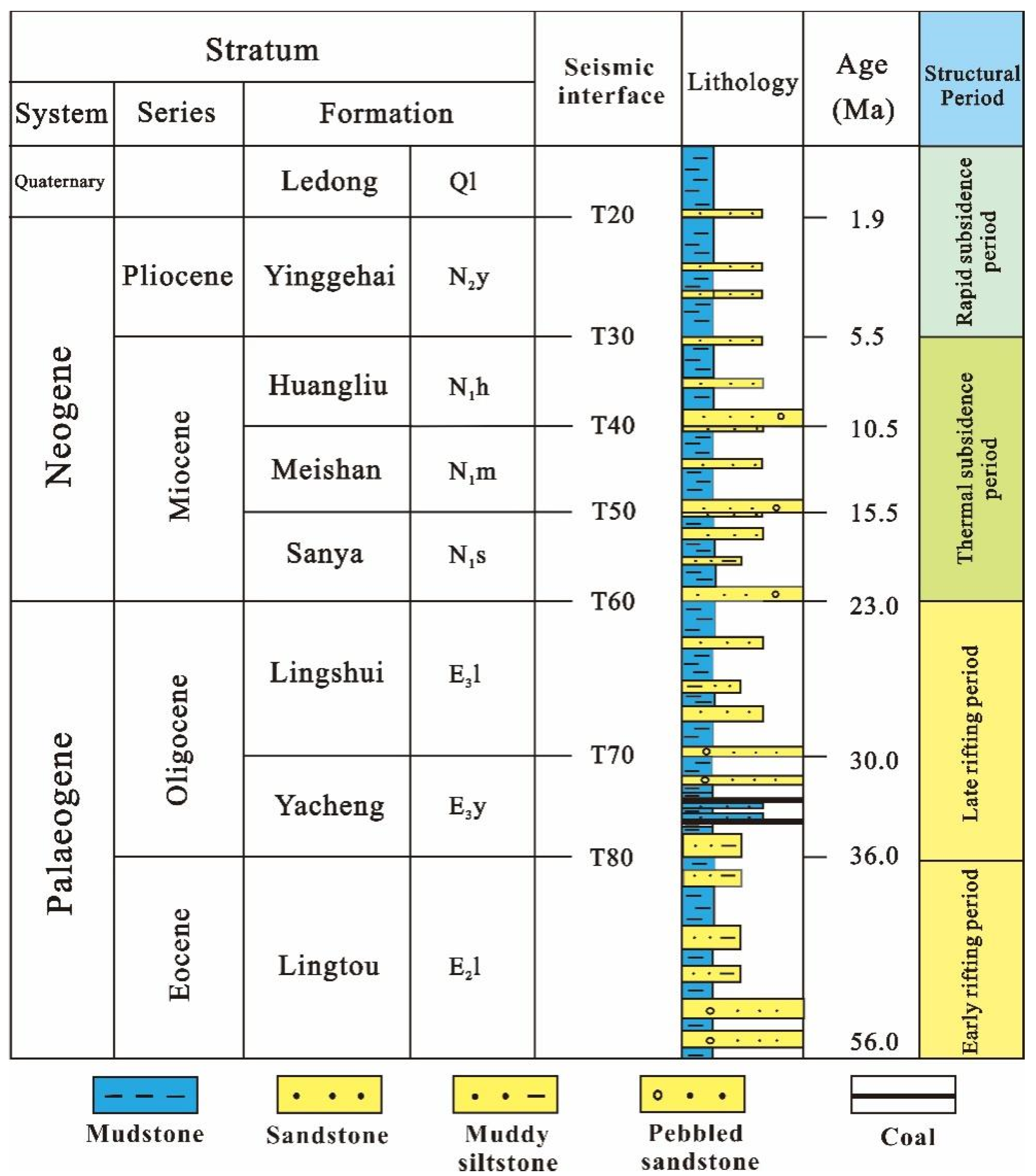


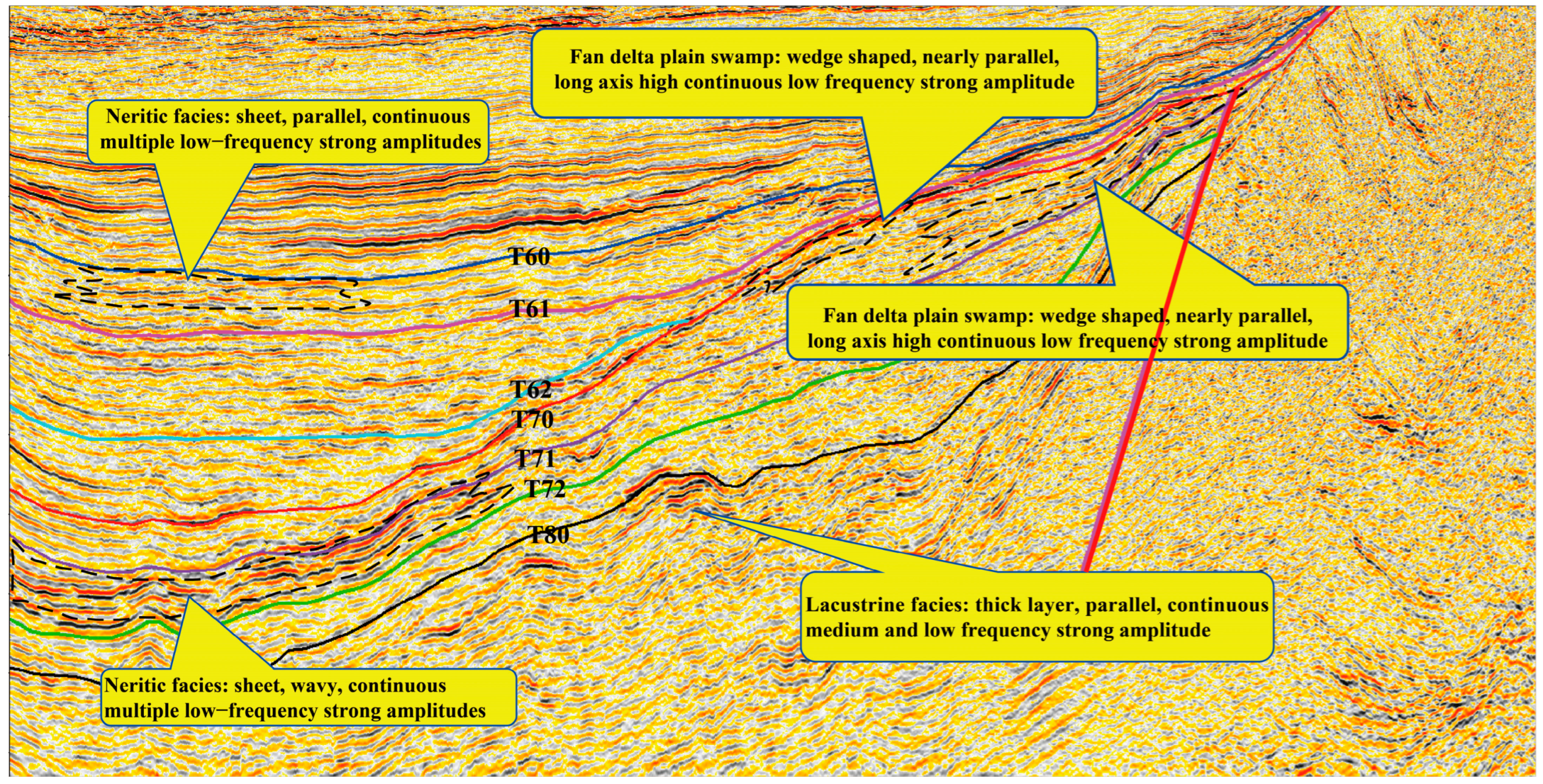
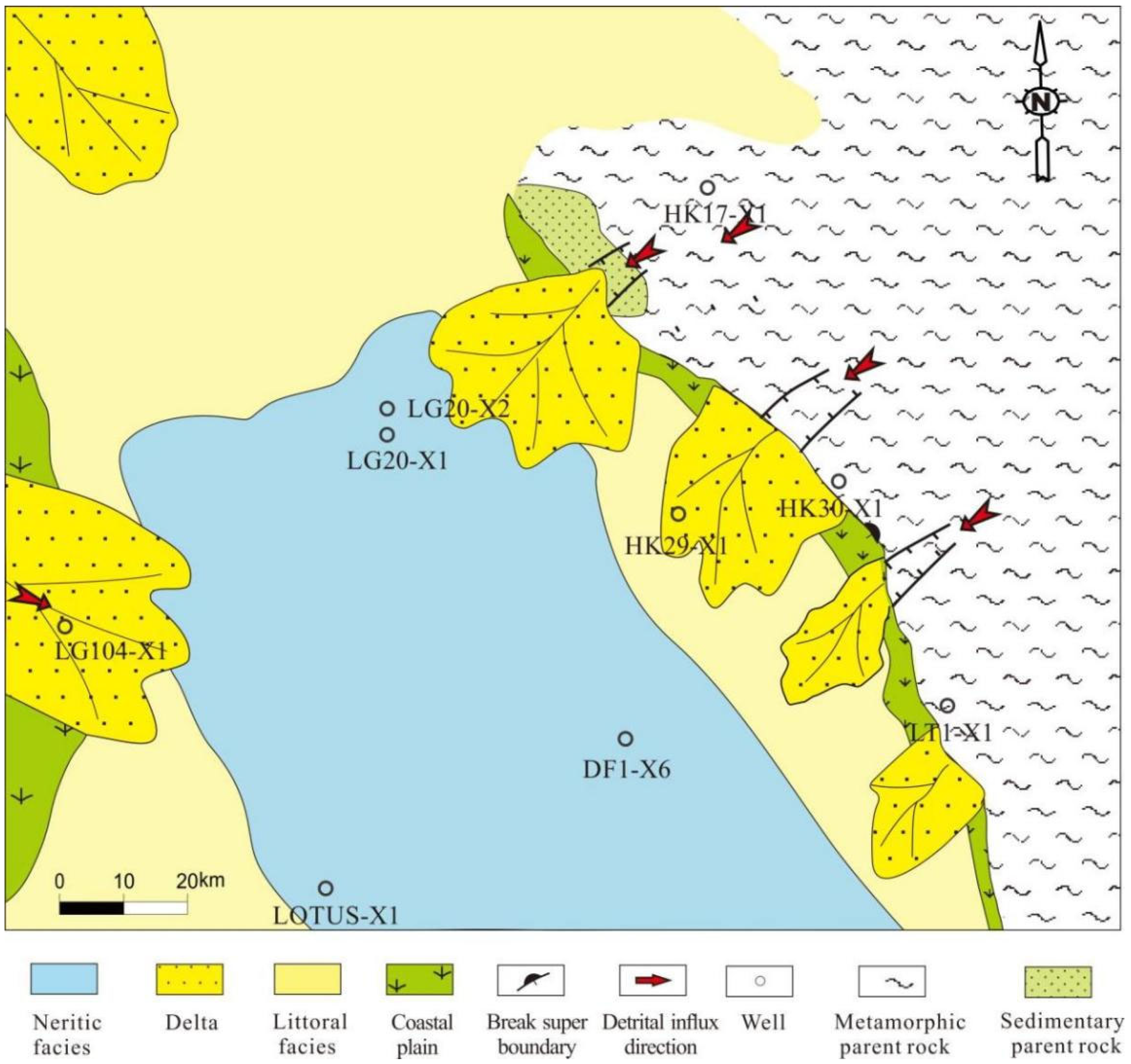
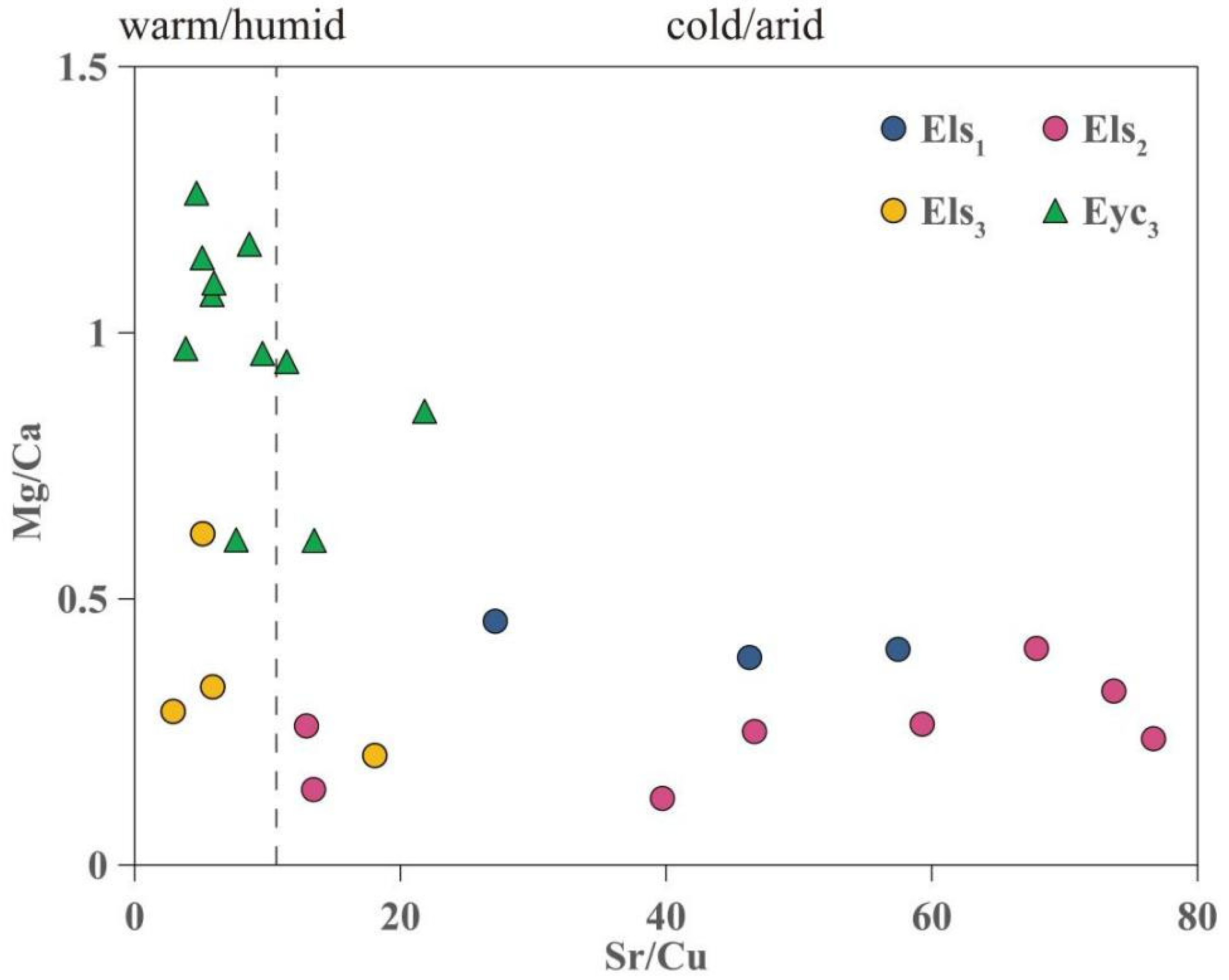
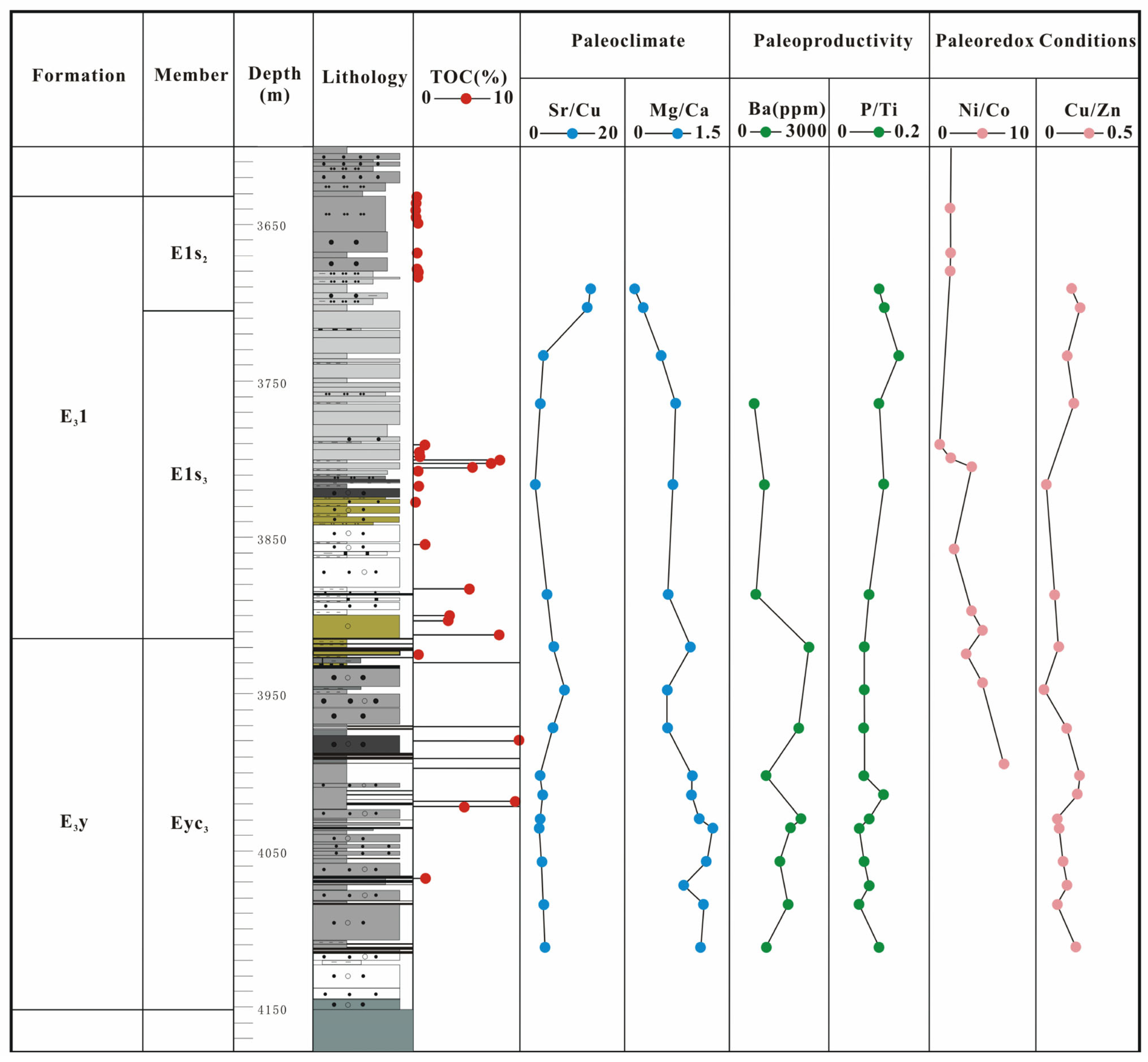

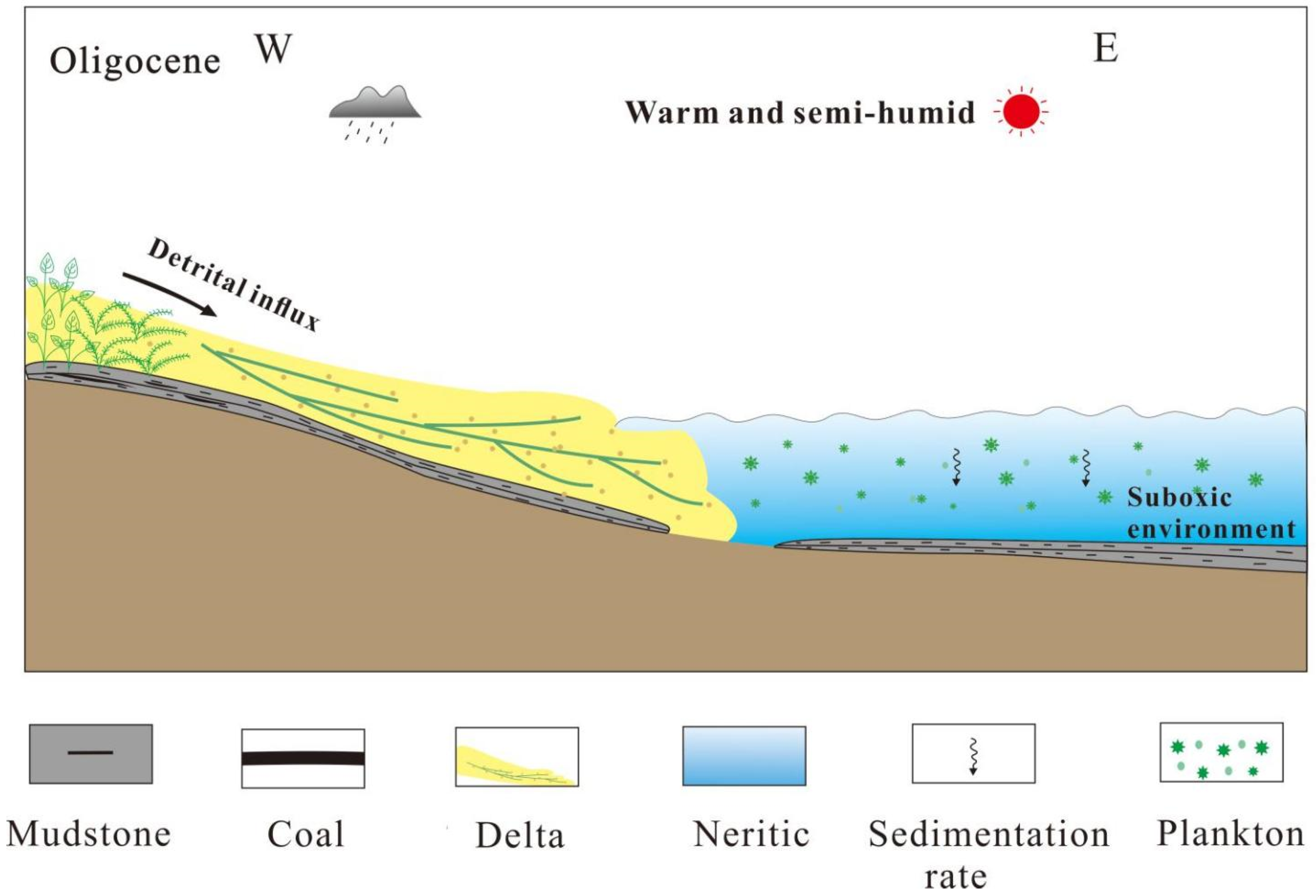

Disclaimer/Publisher’s Note: The statements, opinions and data contained in all publications are solely those of the individual author(s) and contributor(s) and not of MDPI and/or the editor(s). MDPI and/or the editor(s) disclaim responsibility for any injury to people or property resulting from any ideas, methods, instructions or products referred to in the content. |
© 2025 by the authors. Licensee MDPI, Basel, Switzerland. This article is an open access article distributed under the terms and conditions of the Creative Commons Attribution (CC BY) license (https://creativecommons.org/licenses/by/4.0/).
Share and Cite
Pei, J.; Hu, G.; Huo, Z.; Chen, Z.; Chen, Y.; Fu, X.; Wang, W.; Liu, H.; Wang, Y.; Luo, J.; et al. Geological Conditions and Sedimentary Models of Oligocene and Eocene Effective Source Rocks in the Northern Yinggehai Basin. J. Mar. Sci. Eng. 2025, 13, 100. https://doi.org/10.3390/jmse13010100
Pei J, Hu G, Huo Z, Chen Z, Chen Y, Fu X, Wang W, Liu H, Wang Y, Luo J, et al. Geological Conditions and Sedimentary Models of Oligocene and Eocene Effective Source Rocks in the Northern Yinggehai Basin. Journal of Marine Science and Engineering. 2025; 13(1):100. https://doi.org/10.3390/jmse13010100
Chicago/Turabian StylePei, Jianxiang, Gaowei Hu, Zhipeng Huo, Zhihong Chen, Yabing Chen, Xiaofei Fu, Weihong Wang, Haiyu Liu, Yanan Wang, Jingshuang Luo, and et al. 2025. "Geological Conditions and Sedimentary Models of Oligocene and Eocene Effective Source Rocks in the Northern Yinggehai Basin" Journal of Marine Science and Engineering 13, no. 1: 100. https://doi.org/10.3390/jmse13010100
APA StylePei, J., Hu, G., Huo, Z., Chen, Z., Chen, Y., Fu, X., Wang, W., Liu, H., Wang, Y., Luo, J., & Chen, G. (2025). Geological Conditions and Sedimentary Models of Oligocene and Eocene Effective Source Rocks in the Northern Yinggehai Basin. Journal of Marine Science and Engineering, 13(1), 100. https://doi.org/10.3390/jmse13010100




